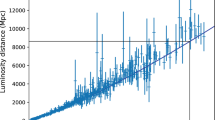Abstract
We consider a cosmological model consistent withobservation which not only explains the well-knownlarge-number coincidences, but also deduces the valuesof the mass, radius, and age of the universe, the Hubble constant and the cosmological constant,a relation between the pion mass and the Hubble constantknown so far only as a mysterious empirical coincidence,and other features. This model predicts an ever-expanding universe, as indeed latestastrophysical data indicate.
Similar content being viewed by others
REFERENCES
Barrow, J. D., and Tipler, F. J. (1986). The Anthropic Cosmological Principle, Oxford University Press, Oxford.
Beesham, A. K. (1994a). International Journal of Theoretical Physics, 33, 1383–1386 (6).
Beesham, A. K. (1994b). International Journal of Theoretical Physics, 33, 1935–1939 (9).
Berman, M. S. (1992). International Journal of Theoretical Physics, 31, 1217–1219 (7).
Berman, M. S. (1996). International Journal of Theoretical Physics, 35, 1033–1035 (5).
Berman, M. S., and Gomide, F. de M. (1994). International Journal of Theoretical Physics, 33, 1933–1934 (9).
Branch, D. (1998). Nature 391, 23–24.
Carvalho, J. C. (1995). International Journal of Theoretical Physics, 34, 2507–2509 (2).
Dirac, P. A. M. (1938). Proceedings of the Royal Society of London A, 165, 199.
Feynman, R. P., and Hibbs, A. R. (1965). Quantum Mechanics and Path Integrals, McGraw-Hill, New York.
Freedman, W. L., et al. (1994). Nature, 371, 757–762.
Hayakawa, S. (1965). Progress of Theoretical Physics Supplement, 532–541.
Huang, K. (1975). Statistical Mechanics, Wiley Eastern, New Delhi.
Ma, G. W. (1995). International Journal of Theoretical Physics, 34, 2501–2506 (12).
Melnikov, V. N. (1994). International Journal of Theoretical Physics, 33, 1509–1579 (7).
Misner, C. W., Thorne, K. S., and Wheeler, J. A. (1973). Gravitation, Freeman, San Francisco.
Perlmutter, S., et al. (1998). Nature 391, 51–54.
Pierece, M. J., et al. (1994). Nature, 371, 385–389.
Rees, M., Ruffini, R., and Wheeler, J. A. (1974) Black Holes, Gravitational Waves and Cosmology: An Introduction to Current Research, Gordon and Breach, New York.
Sidharth, B. G. (1997a). Quantum mechanical black holes: An alternative perspective, Proceedings of International Conference on Frontiers of Quantum Physics, Springer-Verlag, Berlin.
Sidharth, B. G. (1997b). The universe of fluctuations, International Journal of Modern Physics A, (In Press).
Sidharth, B. G. (1997c). Quantum mechanical black holes: Towards a unification of quantum mechanics and general relativity, Indian Journal of Pure and Applied Physics, 35, 456–471 (7).
Weinberg, S. (1972). Gravitation and Cosmology, Wiley, New York.
Rights and permissions
About this article
Cite this article
Sidharth, B.G. Large Numbers and the Time Variation of Physical Constants. International Journal of Theoretical Physics 37, 1307–1312 (1998). https://doi.org/10.1023/A:1026684022878
Issue Date:
DOI: https://doi.org/10.1023/A:1026684022878




